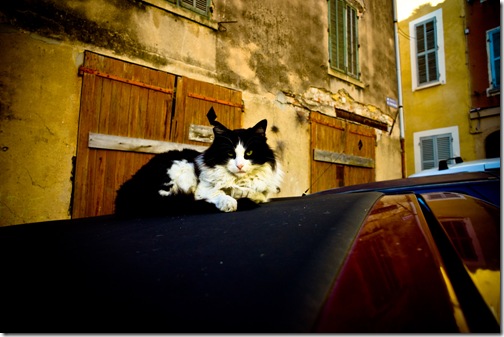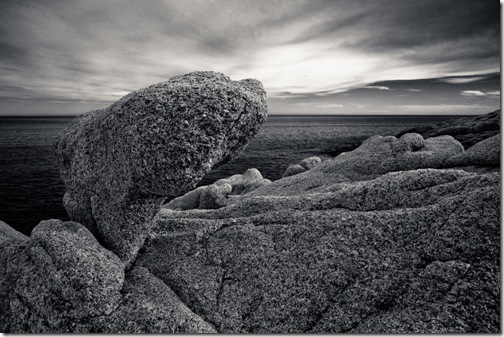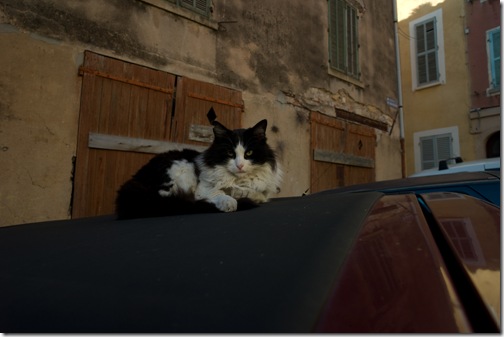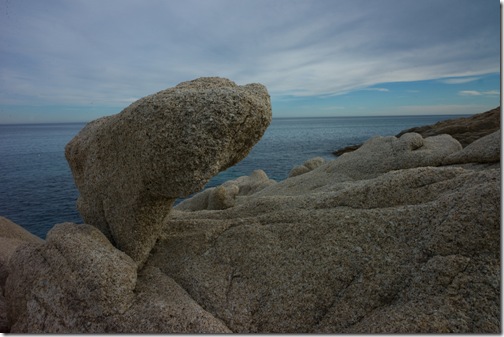Picture of a French cat sitting on a car. Leica M9, Elmarit 21 Asph, f8 @ 125 sec 160 ISO. Worked on in Lightroom. See below to see the original.
When I had my Leica M3 I used to guess the exposure and often the focus too. I used to get away with it most of the time. Imagine my surprise when many of the first pictures I took with the M9 were badly exposed, out of focus or had camera shake. What was going on? I thought I was an OK photographer but here I was making the most basic of mistakes.
All the pictures I take with the M9 are uncompressed DNGs and I work on them in Adobe Lightroom which came with the camera. It is a very powerful program which takes some learning. I was lucky that I have a mate who is a Pro who has been using it for a few years and he showed me the basics so I could at least get started.
The problem is that the images from the M9 are enormous at 18 mega pixel (4 times more than the Digilux 2 it replaced) so when you zoom in to 100% you really can see any faults. Before, these slight issues were never a problem, I never printed anything bigger than 5 x 7 and at this small size they were not noticeable.
Apparently I was not such a good photographer as I thought I was. Must do better. One of the advantages of not having a mirror behind the lens is that the camera can be held at much lower speeds. That said, one must still hold the camera steadily and not jerk it when you press the shutter. It is entirely possible to take good hand held pictures at an 1/8th of a second but only if you take great care, I had not been taking care.
My exposures were not too bad but I had been spoiled by the Digilux 2 which had three different metering options. Often when shooting into the sun, I would put the meter on ‘spot’, move the camera to the area I wanted exposed correctly, lock the exposure, then move the camera to frame the shot. This was very effective but it’s not quite the same on the M9. I can lock the exposure but I lose the soft shutter option which is a shame.
As for my focusing, well the less said about that the better. It didn’t help that the first lens I put on the M9 was a 50mm as I’d been used to a 21mm before. Again, I had become lazy. The autofocus on the Digilux worked very well and I rarely focused manually.
The great thing about the M9 is that you HAVE to use it manually and thus you regain the control like it or not. Dropping back into the M philosophy after five years of letting the camera do everything for me was initially a bit of a shock but it didn’t take long until I was feeling more at home with the camera.
The thing is I took some fabulous pictures with the Digilux but as good as they were, I always felt they were lacking some vital ingredient. Now I know what that was. It was the photographer! It does seem strange to be going back to a completely manual system but it works. I like the way it forces you to consider everything before you take a picture.
Not only did I have to learn to use a camera properly but I also had to learn the program I needed to view the images. I used to be a bit of a purist when it came to taking pictures, I never messed about with my images or even cropped them. A true photographer does not need to correct mistakes. His pictures are perfect straight out of the camera. With the advent of digital I am beginning to change my views.
Leica M9, Elmarit 21 Asph f8 @125 sec, 160 ISO. After much work in Lightroom. See below to view the original shot.
After all, I can shoot in colour and convert to black and white if I want. DNGs are amazingly tolerant and I can easily adjust the exposure if I get it wrong. That’s not to say I am slack when I shoot but it does mean that I have often managed to rescue an image that would have been lost using film. It seems that adjusting images post camera is perfectly acceptable these days.
Now that I am losing my purism I am having a lot of fun with Lightroom. I still prefer not to mess about or crop but I cannot deny that some pictures are improved amazingly. The quality of my work has improved because of the extra care I have to take. It’s a continuous learning experience and very satisfying because of it.
Completely untouched as it came out of the camera. Picture was a little under exposed to begin with. Even after adjusting the exposure it was still only a mediocre shot so I gave it some more colour and contrast and a bit of a vignette too. I rather like it.
Here again, a perfectly ordinary shot. Nothing very interesting at all. Change to black and white and increase brightness and contrast (mainly) and you have something more interesting.




“A true photographer does not need to correct mistakes. His pictures are perfect straight out of the camera”…I couldn’t agree more. I am sick of seeing people boasting that they are great photographers and talk as if they are geniuses in photography when there only skill is taking random images and enhancing them using photoshop.